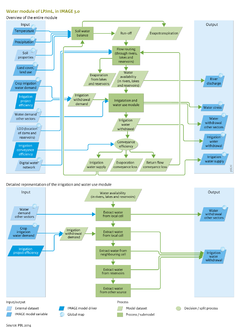Water: Difference between revisions
Jump to navigation
Jump to search
No edit summary |
No edit summary |
||
| Line 9: | Line 9: | ||
|Description=Water availability is essential for natural vegetation and agricultural production, human settlements and industry. Around one third of the world’s population lives in countries suffering from medium to high water stress ([[OECD, 2012]]). This number is expected to increase as the water demand will increase due to the population growth, and as water availability may decrease due to global warming. | |Description=Water availability is essential for natural vegetation and agricultural production, human settlements and industry. Around one third of the world’s population lives in countries suffering from medium to high water stress ([[OECD, 2012]]). This number is expected to increase as the water demand will increase due to the population growth, and as water availability may decrease due to global warming. | ||
Today, agriculture accounts for 70% of the total global water withdrawals. Around one third of the total global crop production is irrigated although only occupying 17% of croplands (e.g. [[Portmann et al., 2010]]). Irrigated agriculture is expected to increase further to meet the growing demand for food ([[Fischer et al., 2005]]; [[Molden, 2007]]; [[FAO, | Today, agriculture accounts for 70% of the total global water withdrawals. Around one third of the total global crop production is irrigated although only occupying 17% of croplands (e.g. [[Portmann et al., 2010]]). Irrigated agriculture is expected to increase further to meet the growing demand for food ([[Fischer et al., 2005]]; [[Molden, 2007]]; [[FAO, 2011a]]). Moreover, water demand in other sectors (domestic, electricity, manufacturing) is projected to increase substantially in the coming decades ([[OECD, 2012]]). As a result, competition between water uses will increase and the resulting water shortages may affect future food production. | ||
Although the global total quantity of freshwater is more than sufficient to meet all human needs, uneven distribution makes water a scarce resource in some regions and watersheds. Furthermore, climate change will lead to changes in precipitation patterns, thus altering future water availability and adding to water stress in areas where precipitation levels are expected to decline. | Although the global total quantity of freshwater is more than sufficient to meet all human needs, uneven distribution makes water a scarce resource in some regions and watersheds. Furthermore, climate change will lead to changes in precipitation patterns, thus altering future water availability and adding to water stress in areas where precipitation levels are expected to decline. | ||
| Line 15: | Line 15: | ||
To identify current and future areas of water stress, IMAGE includes a hydrology model that calculates water availability and demand. The hydrological module of LPJmL is fully integrated with the terrestrial carbon and land-use dynamics of LPJmL and the rest of IMAGE and dynamically calculates agricultural water demand as well as water availability and withdrawals. Availability of renewable water is the net result of precipitation, interception loss and evapotranspiration by plants and soils. In the model, the surplus in each grid cell flows to neighbouring grid cells in a watershed by means of a river routing scheme. However, river flows are modified by dams and reservoirs used for irrigation, and hydropower production or both. | To identify current and future areas of water stress, IMAGE includes a hydrology model that calculates water availability and demand. The hydrological module of LPJmL is fully integrated with the terrestrial carbon and land-use dynamics of LPJmL and the rest of IMAGE and dynamically calculates agricultural water demand as well as water availability and withdrawals. Availability of renewable water is the net result of precipitation, interception loss and evapotranspiration by plants and soils. In the model, the surplus in each grid cell flows to neighbouring grid cells in a watershed by means of a river routing scheme. However, river flows are modified by dams and reservoirs used for irrigation, and hydropower production or both. | ||
The effects of water stress on crop production can be quantified, and by including the feedback of water-limited crop production on land allocation, IMAGE can produce more realistic scenarios for cropland expansion and agricultural intensification. IMAGE and LPJmL are fully and dynamically linked (see [[Carbon, vegetation, agriculture and water]]), and thus IMAGE scenarios include an integrated assessment of the water cycle, and can be used to assess water availability and demand at high spatial (0.5x0.5 degree grid cells) and daily resolutions. | The effects of water stress on crop production can be quantified, and by including the feedback of water-limited crop production on land allocation, IMAGE can produce more realistic scenarios for cropland expansion and agricultural intensification. IMAGE and LPJmL are fully and dynamically linked (see [[Carbon, vegetation, agriculture and water]]), and thus IMAGE scenarios include an integrated assessment of the water cycle, and can be used to assess water availability and demand at high spatial (0.5x0.5 degree grid cells) and daily resolutions. | ||
|ComponentCode=H | |ComponentCode=H | ||
|AggregatedComponent=Carbon, vegetation, agriculture and water | |AggregatedComponent=Carbon, vegetation, agriculture and water | ||
|FrameworkElementType=state component | |FrameworkElementType=state component | ||
}} | }} | ||
Revision as of 14:34, 20 May 2014
| Component is implemented in: |
|
| Related IMAGE components |
| Projects/Applications |
| Key publications |
| References |
Key policy issues
- What is the combined effect of climate change and socio-economic development on water demand and availability, and on associated agricultural production?
- What is the potential of adaptation measures to reduce water stress and water-related crop production losses?
- How can water demand be reduced and still provide the adequate service levels to the sectors with the highest demand?
